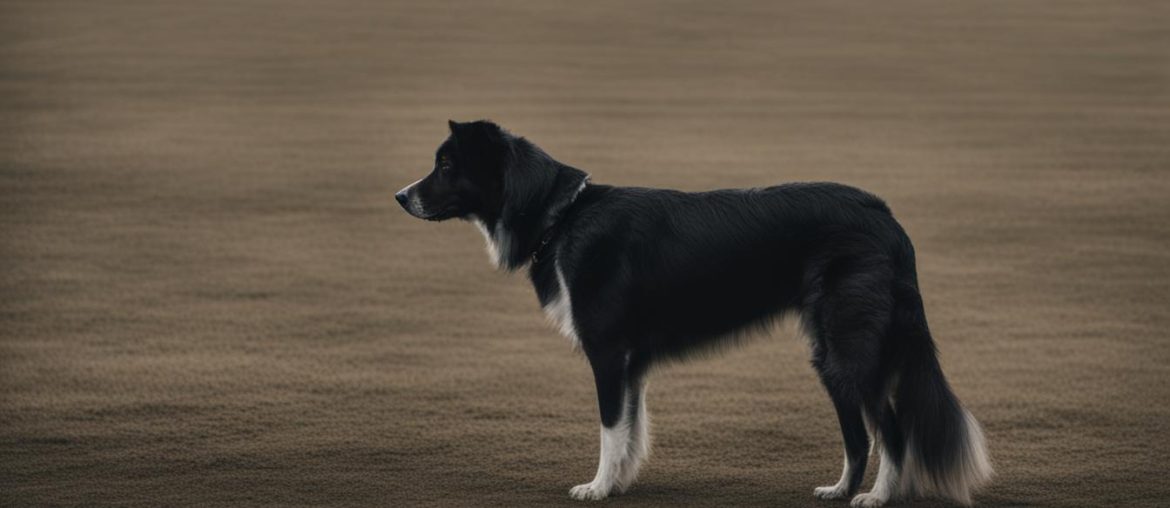A dog’s tail is a crucial part of their body language, providing insights into their emotional state and communication. Understanding why a dog’s tail is down can help interpret their emotions and address underlying issues effectively. From fear and anxiety to physical injury and cognitive decline, there are various reasons why a dog’s tail may be positioned down. By decoding their tail language and considering other body cues, owners can better communicate with their pets and promote their overall well-being.
Key Takeaways:
- A dog’s tail position can indicate their emotional state and communication.
- A lowered tail can be a sign of fear, anxiety, pain, stress, submission, relaxation, or aggression.
- Other body language cues should be considered alongside the tail position to interpret a dog’s emotions accurately.
- Fear and anxiety can cause a dog to tuck their tail between their legs.
- Physical injury, illness, and cognitive decline in senior dogs can contribute to a lowered tail position.
Understanding A Dog’s Tail Language

A dog’s tail language is a vital aspect of canine communication. How dogs hold, wag, and move their tails can convey important information about their emotional state and intentions. Different tail positions, such as high, low, tucked, or relaxed, can have specific meanings. Understanding a dog’s tail language can help owners better communicate with their pets and identify potential issues.
Interpreting dog tail movements requires paying attention to the overall context and body language cues. For example, a high tail position with vigorous wagging often indicates excitement or happiness. On the other hand, a low tail position that is tucked between the hind legs suggests fear, anxiety, or submission. It is essential to consider the combination of tail position, ear position, facial expressions, and body posture to accurately interpret a dog’s emotional state.
Here are some common dog tail positions and their meanings:
- High Tail: A high, raised tail often indicates confidence, excitement, or alertness.
- Low Tail: A low, tucked tail can signify fear, anxiety, submission, or insecurity.
- Relaxed Tail: A relaxed tail is usually in a neutral position, gently hanging downward. It suggests that the dog is calm and content.
- Wagging Tail: Tail wagging can have various meanings depending on the speed, intensity, and direction. A broad, loose wag often indicates friendliness and happiness, while a stiff, fast wag may signal agitation or potential aggression.
Understanding a dog’s tail language is crucial for building a strong bond and ensuring their well-being. By observing their tail position and accompanying body language, owners can communicate more effectively with their furry companions and address any potential issues promptly.
7 Common Reasons for a Dog’s Tail to Be Down
| Reason | Description |
|---|---|
| Fear | A dog may hold its tail down when it is scared or anxious. This can be accompanied by other signs such as pinned ears, a tight mouth, and wide-eyed expression. |
| Submissive Appeasement Signal | A dog may hold its tail low as a submissive appeasement signal. This is a way for the dog to communicate that it is not a threat and is trying to show deference to a more dominant individual. |
| Warning and Aggression | In some cases, a dog may hold its tail down as a warning sign of aggression. This can be accompanied by defensive aggressive reactions such as raised hackles, a wrinkled nose, and showing teeth. |
| Relaxed Dogs Hold Their Tails Down Too | Not all dogs with their tails down are experiencing negative emotions. Some dogs naturally hold their tails in a low, relaxed position. |
| Physical Injury or Broken Tail | If a dog has suffered a physical injury or has a broken tail, it may hold its tail low to protect it. Symptoms such as pain, swelling, and obsessive licking or chewing may also be present. |
| Illness or Disease | Underlying illnesses or diseases such as hip dysplasia, arthritis, spinal cord injuries, and nerve damage can cause a dog to hold its tail in a low position. |
| Limber Tail Syndrome | Also known as swimmers tail, this condition can cause a dog’s tail to hang limply and low. It is often seen in dogs that have engaged in vigorous exercise or swimming. |
| Cognitive Decline, Arthritis, or Stress in Senior Dogs | Senior dogs may hold their tails low due to cognitive decline, arthritis, or stress. These conditions can cause discomfort and affect their overall well-being. |
There are several common reasons why a dog’s tail may be down. Fear is a common cause, with dogs often tucking their tails between their legs when they are scared or anxious. This fear can be accompanied by other signs such as pinned ears, a tight mouth, and a wide-eyed expression. Dogs may also hold their tails low as a submissive appeasement signal, indicating that they are not a threat and are showing deference to a more dominant individual.
In some cases, a dog may hold its tail down as a warning sign of aggression. Defensive aggressive reactions such as raised hackles, a wrinkled nose, and showing teeth may accompany this behavior. However, it’s important to note that not all dogs with their tails down are experiencing negative emotions. Some dogs naturally hold their tails in a low, relaxed position, even when they are not feeling fearful or anxious.
Physical injury or a broken tail can also cause a dog to hold its tail low. Dogs may do this to protect their injured tail, and symptoms such as pain, swelling, and obsessive licking or chewing may be present. Underlying illnesses or diseases such as hip dysplasia, arthritis, spinal cord injuries, and nerve damage can also result in a dog holding its tail in a low position. Additionally, a condition called limber tail syndrome, commonly known as swimmers tail, can cause a dog’s tail to hang limply and low, particularly in dogs that have engaged in vigorous exercise or swimming. Lastly, senior dogs may hold their tails low due to cognitive decline, arthritis, or stress, which can cause discomfort and affect their overall well-being.
Wrapping Up
To sum up, understanding why a dog’s tail is down is crucial for interpreting their emotions and addressing any underlying issues. A dog’s tail language is a vital aspect of canine communication, and by paying attention to it along with other body language cues, owners can better understand their pets.
When a dog’s tail is down, it can indicate fear, anxiety, pain, stress, submission, relaxation, or aggression. It’s important to consider the overall context and body language to accurately interpret the meaning behind a lowered tail position.
To address underlying issues and promote a dog’s well-being, it’s essential to provide appropriate care. This may include consulting with a veterinarian for diagnosis and treatment, implementing behavior modification techniques, and ensuring proper pain management. By addressing these underlying issues, we can help our furry friends feel more comfortable and content.
To sum up, understanding and interpreting a dog’s tail language is key to strengthening the bond between humans and dogs. By promoting their well-being and addressing any underlying issues, we can create a happier and healthier environment for our beloved pets.
FAQ
Why is my dog’s tail down?
A dog’s tail position can indicate their emotional state. It may be down due to fear, anxiety, pain, stress, submission, relaxation, aggression, limp tail syndrome, injury, or cognitive decline in senior dogs.
What does it mean if my dog’s tail is tucked between its legs?
If a dog’s tail is tucked between its legs, it is often a sign of fear or anxiety.
Why does my dog hold its tail low as a submissive appeasement signal?
Holding the tail low can be a way for a dog to communicate that they are not a threat and are showing deference to a more dominant individual.
Is a dog with a low tail always aggressive?
Not necessarily. A dog with a low tail can be showing signs of fear or anxiety, but it can also be a warning sign of aggression. It’s important to assess other body language cues to determine the dog’s intentions.
Can a relaxed dog also have its tail held down?
Yes, a relaxed dog may have its tail in a gentle downward curve or neutral position, which is still considered a low tail position.
What could be causing my dog’s tail to be down due to physical injury?
Injuries or broken tail can cause a dog to hold its tail down. Symptoms may include swelling and obsessive licking or chewing.
Are there any illnesses or diseases that can cause a low tail position?
Yes, conditions such as hip dysplasia, arthritis, spinal cord injuries, and nerve damage can contribute to a lowered tail position.
What is limber tail syndrome and can it cause a dog’s tail to hang low?
Limber tail syndrome, also known as swimmers tail, can cause a dog’s tail to hang limply and low. It is commonly seen in swimming dogs or those that have engaged in vigorous exercise.
Why do senior dogs often hold their tails low?
Senior dogs may hold their tails low due to cognitive decline, arthritis, or stress. These conditions can cause discomfort and affect a dog’s overall well-being.






